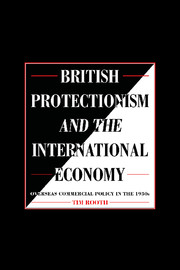Book contents
- Frontmatter
- Contents
- Preface
- List of Tables
- Introduction
- 1 Britain's international economic position in the 1920s
- 2 The political economy of protectionism
- 3 Imperial preference and the Ottawa Conference
- 4 The Scandinavian negotiations: formulation of policy
- 5 Completion of the first phase of negotiations: Scandinavia, Germany and Argentina
- 6 The world economic conference, Finland and Japanese competition
- 7 The Baltic states and Poland
- 8 British agricultural policy and imports during the 1930s
- 9 British exports to the trade agreement countries
- 10 Appeasing Germany and the United States
- 11 Some general conclusions
- Appendix A United Kingdom: payments, clearing etc., Agreements in force 1931–1938
- Appendix B Miscellaneous trade and payments agreements
- Appendix C Imports into Britain from foreign agreement countries
- Appendix D Total exports from Britain to foreign agreement countries and four dominions
- Appendix E Imports of selected commodities into UK, 1931, 1937, showing percentage from Empire sources
- Bibliography
- Index
Appendix B - Miscellaneous trade and payments agreements
Published online by Cambridge University Press: 06 July 2010
- Frontmatter
- Contents
- Preface
- List of Tables
- Introduction
- 1 Britain's international economic position in the 1920s
- 2 The political economy of protectionism
- 3 Imperial preference and the Ottawa Conference
- 4 The Scandinavian negotiations: formulation of policy
- 5 Completion of the first phase of negotiations: Scandinavia, Germany and Argentina
- 6 The world economic conference, Finland and Japanese competition
- 7 The Baltic states and Poland
- 8 British agricultural policy and imports during the 1930s
- 9 British exports to the trade agreement countries
- 10 Appeasing Germany and the United States
- 11 Some general conclusions
- Appendix A United Kingdom: payments, clearing etc., Agreements in force 1931–1938
- Appendix B Miscellaneous trade and payments agreements
- Appendix C Imports into Britain from foreign agreement countries
- Appendix D Total exports from Britain to foreign agreement countries and four dominions
- Appendix E Imports of selected commodities into UK, 1931, 1937, showing percentage from Empire sources
- Bibliography
- Index
Summary
The United Kingdom made, and attempted to make, a number of other trade and payments agreements. There were two unsuccessful efforts to seek full trade agreements on the model of the North European and Argentine treaties: in the case of Spain nothing was achieved, while with Peru only a limited agreement resulted. The other treaties were essentially defensive measures to redress discrimination against British products or to unfreeze blocked payments.
The limitations on Britain's bargaining power were amply demonstrated in a series of frustrating negotiations with Peru, Spain and Turkey.
Peru
The Foreign Office, anxious to counter the United States trade drive in Latin America, had provided the main pressure within Whitehall for negotiations with Peru. The Board of Trade had been sceptical of achieving much because Britain lacked the power to hurt Peruvian export interests. On the other hand, Japanese textiles had been making inroads into the market and the Board did see some chances of bolstering Lancashire's position. The final outcome, after long and difficult negotiations, was not especially fruitful for the United Kingdom. Some reductions in the tariff rates, raised by Peru during the course of discussions, were secured, and private purchasing arrangements were concluded between British exporters and Peruvian cotton, wool and sugar interests. Benevolent treatment of UK investments in Peru was promised by the government, and, in a confidential note, the Peruvian administration made undertakings, albeit weak ones, to encourage government departments and agencies to give opportunities for British exporters to tender for contracts.
- Type
- Chapter
- Information
- British Protectionism and the International EconomyOverseas Commercial Policy in the 1930s, pp. 324 - 329Publisher: Cambridge University PressPrint publication year: 1993



